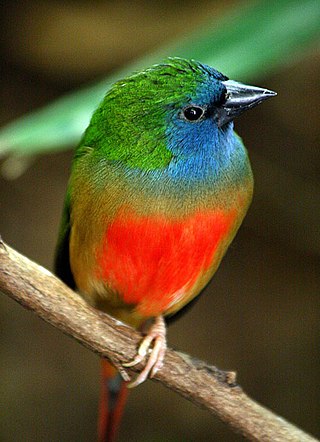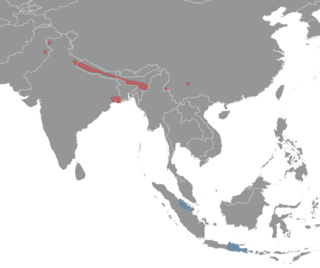
The Laotian rock rat or kha-nyou, sometimes called the "rat-squirrel", is a species of rodent found in the Khammouan region of Laos. The species was first described in a 2005 article by Paulina Jenkins and coauthors, who considered the animal to be so distinct from all living rodents, they placed it in a new family, Laonastidae. It is in the monotypic genus Laonastes.

The Siamese fireback, also known as Diard's fireback, is a fairly large, approximately 80 cm (31 in) long, pheasant. The male has a grey plumage with an extensive facial caruncle, crimson legs and feet, ornamental black crest feathers, reddish brown iris and long curved blackish tail. The female is a brown bird with blackish wing and tail feathers.

The large-spotted civet is a viverrid native to Southeast Asia that is listed as Endangered on the IUCN Red List.

The large Indian civet is a viverrid native to South and Southeast Asia. It is listed as Least Concern on the IUCN Red List. The global population is considered decreasing mainly because of trapping-driven declines in heavily hunted and fragmented areas, notably in China, and the heavy trade as wild meat.

The genus Mus or typical mice refers to a specific genus of muroid rodents, all typically called mice. They are the only members of the tribe Murini. However, the term mouse can also be applied to species outside of this genus.
The Cypriot mouse is a species of mouse endemic to Cyprus. Its primary habitat seems to be the vineyards and fields of the Troödos Mountains region.

The pin-tailed parrotfinch is a common species of estrildid finch found in Southeast Asia: Malaysia, Brunei, Cambodia, Indonesia, Laos, Burma, Vietnam, Thailand and China. It has an estimated global extent of occurrence of 10,000,000 km2.

The Luzon montane forest mouse is a species of rodent in the family Muridae, from the genus Apomys. It occurs only in the Philippines, where it has been found on the large northern island Luzon. It is most closely related to the large Mindoro forest mouse, which occurs on Mindoro. There may be another related species in the Sierra Madre, but this species is yet undescribed. The Luzon montane forest mouse is a relatively large, ground-dwelling rat with a tail that is quite short for its genus.

The Indomalayan pencil-tailed tree mouse or simply pencil-tailed tree mouse is a species of arboreal rodent in the family Muridae. It is found in northeastern India, southern China, Myanmar, Thailand, Laos, Cambodia, Vietnam, Peninsular Malaysia, and Indonesia. This locally abundant but patchily distributed species occurs in primary and secondary forests, without affinity to particular forest types. It can suffer from deforestation and is sometimes harvested for consumption.

The Ryukyu mouse is a species of rodent in the family Muridae. It is found in Cambodia, China, Indonesia, Japan, Laos, Malaysia, Taiwan, Thailand, and Vietnam.

The fawn-colored mouse is a species of rodent in the family Muridae. It is found in Cambodia, India, and possibly Indonesia, Laos, Myanmar, Nepal, Thailand, and Vietnam.
The Ceylon spiny mouse is a species of rodent in the family Muridae. It is found only in Sri Lanka, where it is known as ශ්රී ලංකා කටු හීන් මීයා in Sinhala language.
The Macedonian mouse is a species of rodent in the family Muridae and order Rodentia. This rodent lives in the area from eastern Georgia and western Bulgaria to Israel. It is considered part of a Paleoarctic group along with three other species: the house mouse, steppe mouse, and Algerian mouse.

Shortridge's mouse is a species of rodent in the family Muridae. It is found in Cambodia, Laos, Myanmar, Thailand, and Vietnam.

The steppe mouse or mound-building mouse is a species of rodent in the family Muridae. It is found in grassland and other open areas in Austria, Bosnia and Herzegovina, Bulgaria, Croatia, Czech Republic, Hungary, North Macedonia, Romania, Serbia and Montenegro, Slovakia, Slovenia, and Ukraine.

The lesser racket-tailed drongo is a species of bird in the family Dicruridae. It is found in the Indian Subcontinent and Southeast Asia.

The ratchet-tailed treepie is a species of bird in the crow and jay family Corvidae. The species is also known as the notch-tailed treepie. It is monotypic within the genus Temnurus.

The Mekong freshwater stingray, Hemitrygon laosensis, is a species of stingray in the family Dasyatidae, restricted to the Mekong and Chao Phraya Rivers in Laos and Thailand; the occurrence in Chao Phraya is considered an introduction. Measuring up to 62 cm (24 in) across, this ray has an oval pectoral fin disc, a tail with both upper and lower fin folds, and a midline row of spine-like dermal denticles. A characteristic feature of this species is its bright orange underside. The Mekong freshwater stingray preys on invertebrates and is aplacental viviparous. It has been assessed as Endangered by the International Union for Conservation of Nature (IUCN), as it is threatened by overfishing and habitat degradation.

Mus is a subgenus of the rodent genus Mus.
The Hispaniola racer or Hispaniolan brown racer is a snake that is endemic to the Caribbean island of Hispaniola. It is monotypic in the genus Haitiophis.
















